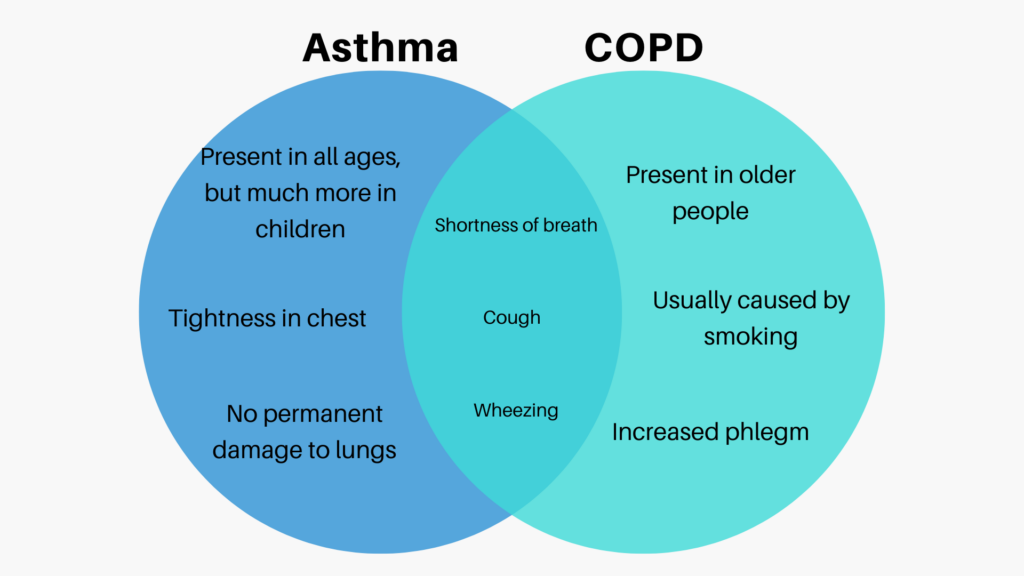Chronic obstructive pulmonary disease (COPD) is a group of lung diseases that makes it more difficult to exhale which causes shortness of breath. COPD is a very common disease worldwide, and in the United States, it is the fourth leading cause of death. Therefore, it is important to understand what the disease is and how to prevent it.
COPD
Overview
In order to move oxygen and CO2 in and out of our bloodstreams, our lungs contain millions of very delicate airways, membranes, and blood vessels. COPD occurs when there is inflammation and structural changes to these delicate structures that lead to reduced airflow. Other symptoms include chest pain, fever and chills, and frequent episodes of pneumonia.
The diseases that make up the vast majority of COPD cases are divided into chronic bronchitis and emphysema.
Chronic bronchitis is caused mostly by inflammation of the airway. This results in the narrowing of the airways and mucus build-up within the airways which restricts airflow and causes a chronic, productive cough. It is characterized by a productive cough that lasts at least three months with recurring episodes lasting up to two years.
Emphysema, on the other hand, is a condition that is caused mostly by the destruction of the airways and membranes within the lungs. Eventually, when a significant amount of lung is destroyed, breathing and movement of gasses into and out of the blood become limited.
What is the main cause of COPD?
COPD can be caused by a range of factors:
- Smoking – By far, smoking tobacco products is the main cause of COPD – contributing to 90% of all cases! So, the good news is that if you aren’t a smoker, you will probably never have to worry about COPD. Smoke from tobacco, marijuana, and “vapes” all contain harmful substances that damage the lungs — as well as the heart — over time. Secondhand smoke, or exposure to smoke from others smoking around you, can also increase the risk of COPD. This is why public smoking restrictions have grown more prevalent and especially children should not be exposed to smokers in homes or cars.
- Dangerous fumes and dust – You can increase the risk of COPD if exposed to coal dust (“black lung”), welding fumes, grain dust, sawdust, and others.
- Air pollution – Living in an environment with poor air quality can lead to COPD. This is particularly a problem in areas of the world where people cook over an open flame or in large cities with heavy pollution. But, even using a gas range can cause enough pollution in our homes to lead to lung damage.
- Genetics – Some of us are genetically predisposed to develop COPD.
What are the early warning signs of COPD?
The early stages of COPD can be difficult to detect, and symptoms may vary depending on the person. There are a few signs that warrant a trip to the doctor:
- Cough – A chronic cough is often one of the first signs of COPD. Coughing that lasts more than three months can be a predictor of COPD and should always be evaluated.
- Shortness of breath – Being short of breath is normal during vigorous exercise, but not when performing daily activities or while on a leisurely walk. Any worsening of our breathing in any circumstance should be evaluated.
- Fatigue – Being unable to move or absorb adequate amounts of oxygen or release adequate amounts of CO2 will cause shortness of breath and a feeling of overall weakness or fatigue. This also should prompt a visit to your doctor.
What is the difference between COPD and asthma?
Like Chronic Bronchitis and Emphysema, Asthma involves the narrowing of the airways, not due to damage or inflammation but as a result of a process most similar to an allergic reaction. But while the underlying causes are different, asthma and COPD share many symptoms, so it can be difficult to tell the difference without a doctor’s opinion. The chart below can help you distinguish Asthma from COPD.

What is the life expectancy of someone with COPD?
Although COPD can be potentially life-threatening, most COPD patients lead mostly normal lives outside of occasional flare-ups. Encouragingly, making lifestyle changes can greatly impact your life expectancy:
- Quit smoking – Smoking will continue to damage your lungs, so it is critical to kick the habit. Even if we have smoked for years, within just a few weeks of quitting, patients notice a significant improvement in their symptoms, and their disease process is greatly slowed.
- Improve indoor air quality – avoid gas stoves, open fireplaces, and unvented gas heaters. Do not allow smoking in your home and keep dust to a minimum. HEPA filtration devices are inexpensive and effective.
- Exercise – Even a 30-minute daily walk can help manage the progression of COPD
- Lose weight – A sedentary lifestyle can lead to shortness of breath which can make COPD worse.
- See a Doctor – Diagnosing COPD early can greatly improve your quality of life and life expectancy
Getting checked can make a difference
COPD or asthma flares can be deadly and sudden and shortness of breath of any kind usually indicates something serious. Therefore, do not wait to see a doctor.
The doctors and nurses at CapRock are experts in managing Asthma and COPD flares and have all the equipment necessary to treat and diagnose the many causes of difficulty breathing. Give us a call if you need an evaluation. We are available 24 hours, every day, at both of our locations.

